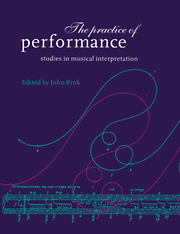Book contents
- Frontmatter
- Contents
- Preface
- PART ONE FUNDAMENTALS
- 1 What do we perform?
- 2 Expression in performance: generativity, perception and semiosis
- 3 Musical motion and performance: theoretical and empirical perspectives
- 4 Deliberate practice and elite musical performance
- PART TWO STRUCTURE AND MEANING IN PERFORMANCE
- PART THREE PERFORMANCE AS PROCESS
- Index
2 - Expression in performance: generativity, perception and semiosis
Published online by Cambridge University Press: 10 October 2009
- Frontmatter
- Contents
- Preface
- PART ONE FUNDAMENTALS
- 1 What do we perform?
- 2 Expression in performance: generativity, perception and semiosis
- 3 Musical motion and performance: theoretical and empirical perspectives
- 4 Deliberate practice and elite musical performance
- PART TWO STRUCTURE AND MEANING IN PERFORMANCE
- PART THREE PERFORMANCE AS PROCESS
- Index
Summary
INTRODUCTION
Empirical and theoretical research during the last fifteen years has established a widely shared view of many of the principles involved in producing expressive musical performances, with a particular concentration on expressive timing properties (e.g. Clarke 1988; Sundberg 1988; Todd 1989). The paradoxical feature of this research is that while all authors recognise the subtlety and sophistication of skilled musical performance, their studies indicate that the principles governing expression in performance are comparatively simple. At the same time listeners appear to extract something from these expressive features which profoundly influences the overall effect of the performance: the simplicity of the general procedures that apply in performance expression seems to belie their communicative force. At the very beginning of empirical research into performance, Seashore (1938) pointed out the complex interaction between characteristics which are part of the performance (accentuations, lengthenings, shortenings, etc.) and properties which the listener may attribute to the performer but which are mental constructs resulting from the listener's own parsing of musical structures. The sense of accent on a metrically strong event, whatever its actual dynamic level, duration or style of articulation, is an example of this phenomenon. Seashore's observation, which has been largely ignored in subsequent research, raises the possibility of a somewhat different approach to understanding the meaning and force of expressive effects in performance – one which takes far more seriously the realities of performance features and the complex interdependence of intrinsic musical structure, stylistic norms and the expectations that they engender. This chapter surveys different approaches to expression in performance and develops a view, based on certain principles in semiotics, which recognises both the systematic simplicity of performance features and their rhetorical force.
- Type
- Chapter
- Information
- The Practice of PerformanceStudies in Musical Interpretation, pp. 21 - 54Publisher: Cambridge University PressPrint publication year: 1995
- 29
- Cited by



